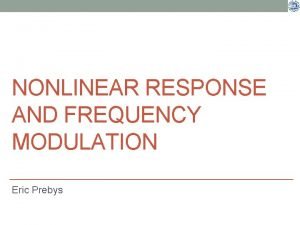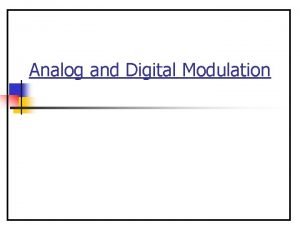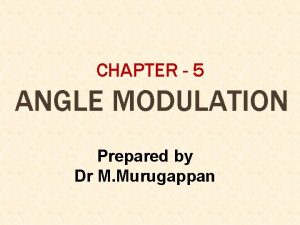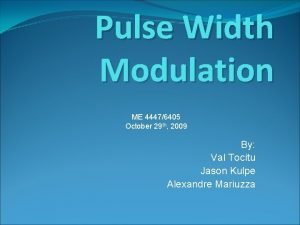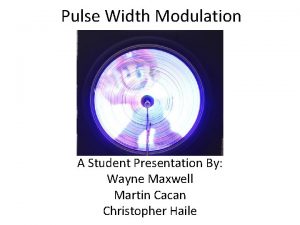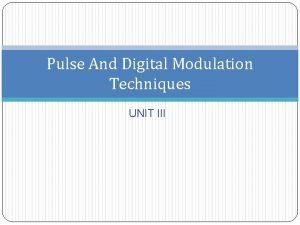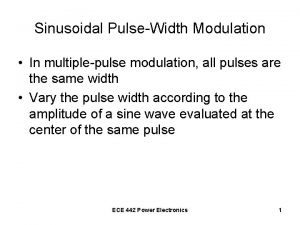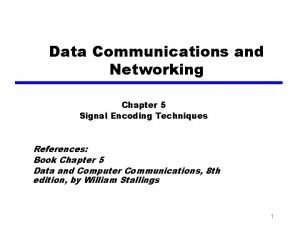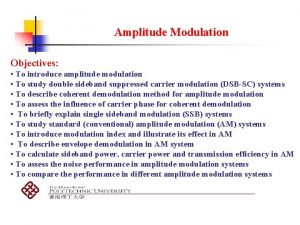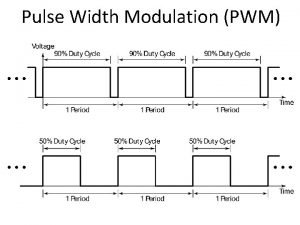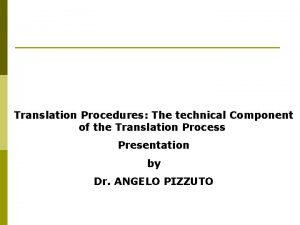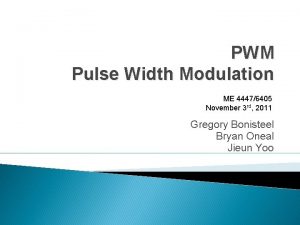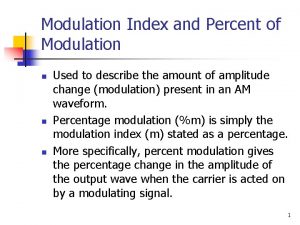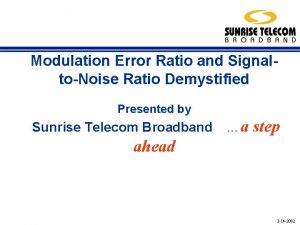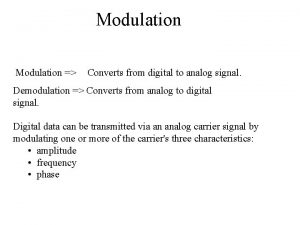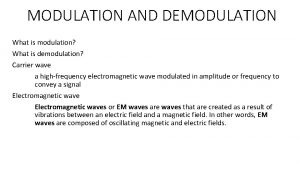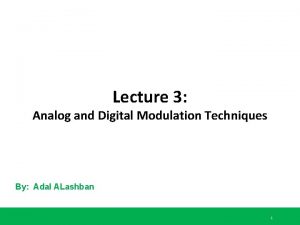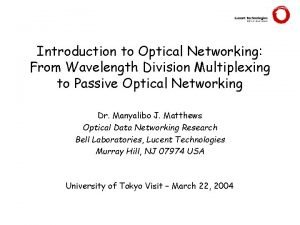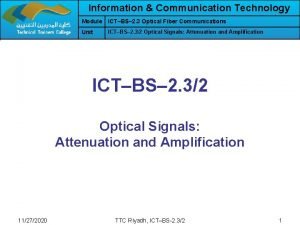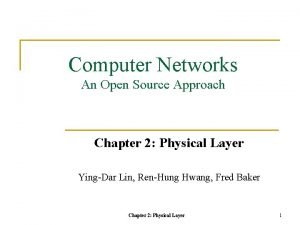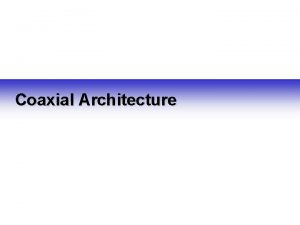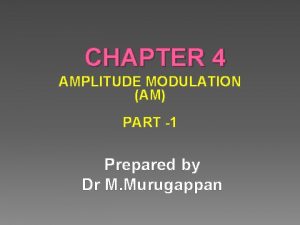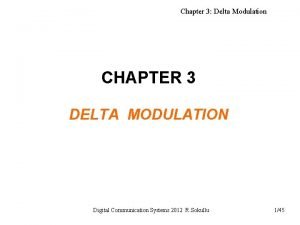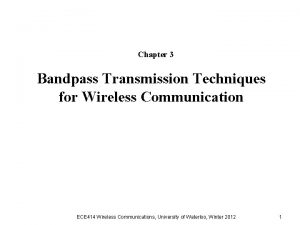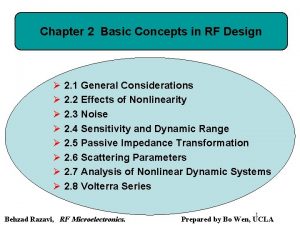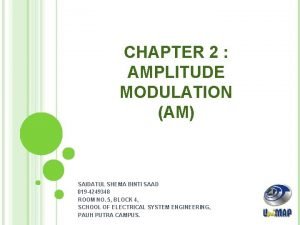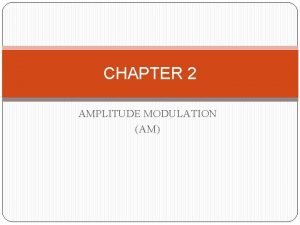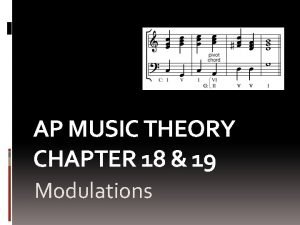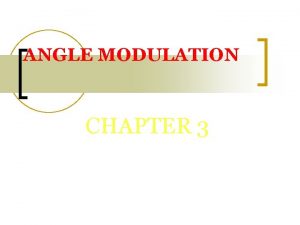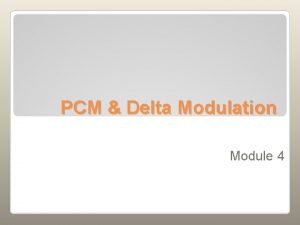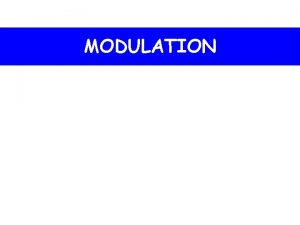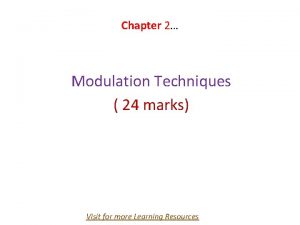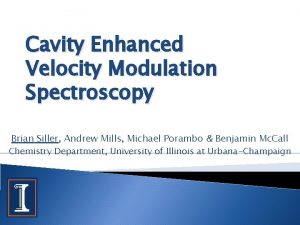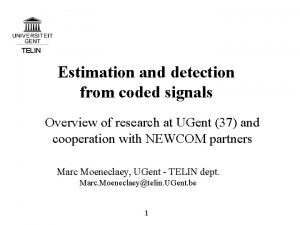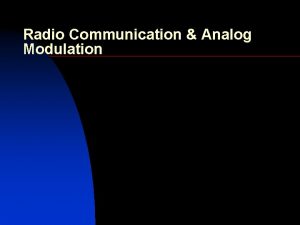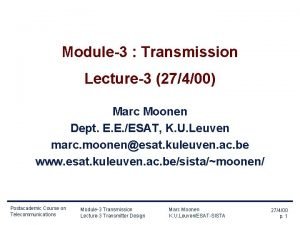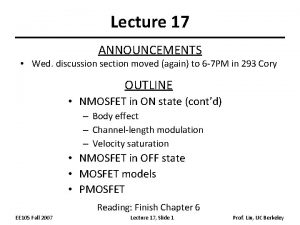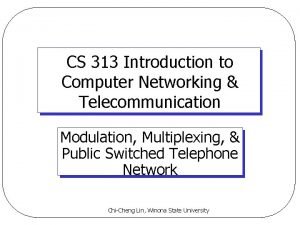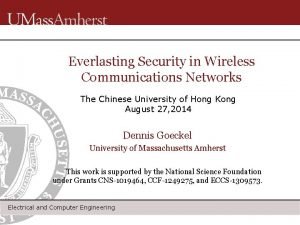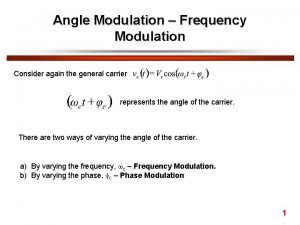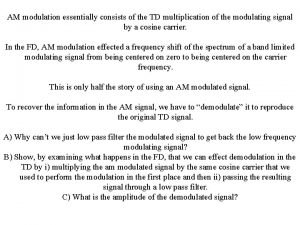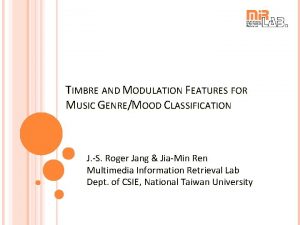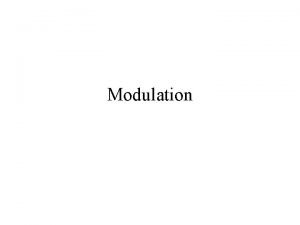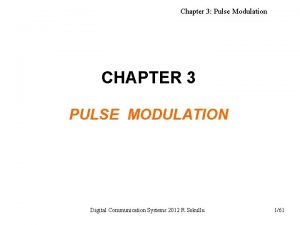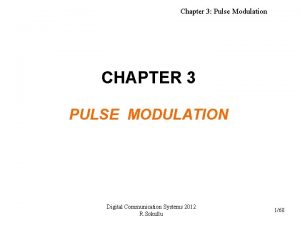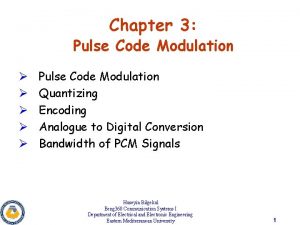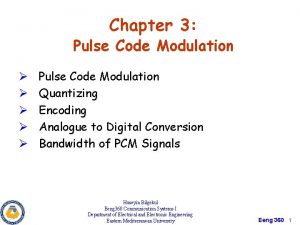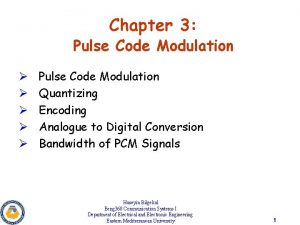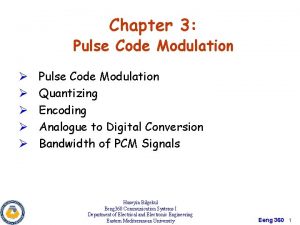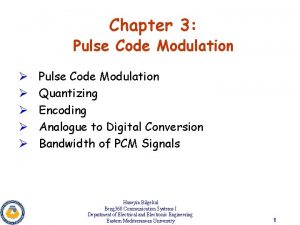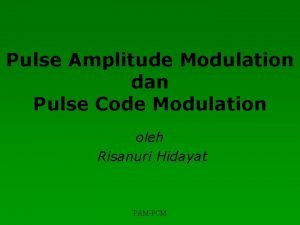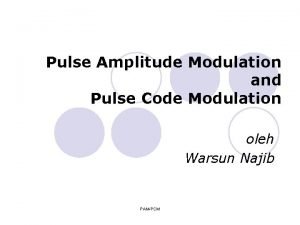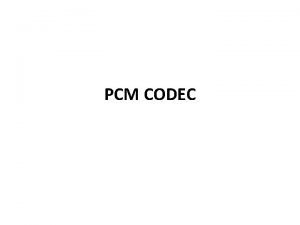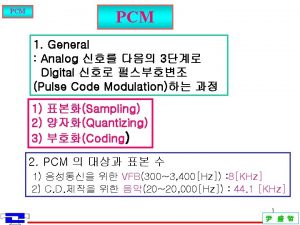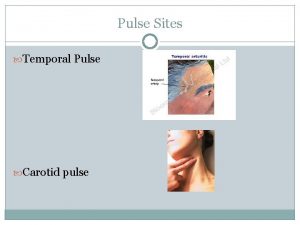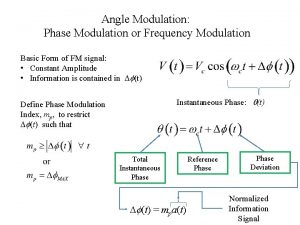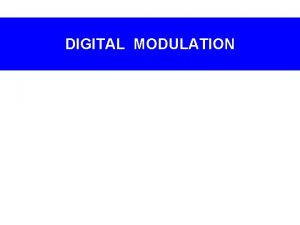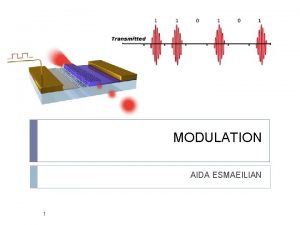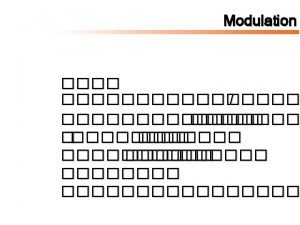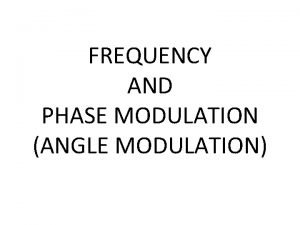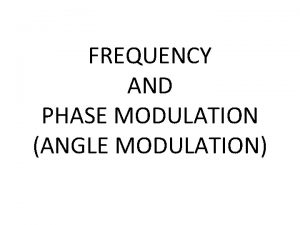Chapter 3 Pulse Modulation 3 1 Introduction 2








































































- Slides: 72

Chapter 3 Pulse Modulation 3. 1 Introduction

2

3

4

5

Figure 3. 3 (a) Spectrum of a signal. (b) Spectrum of an undersampled version of the signal exhibiting the aliasing phenomenon. 6

Figure 3. 4 (a) Anti-alias filtered spectrum of an information-bearing signal. (b) Spectrum of instantaneously sampled version of the signal, assuming the use of a sampling rate greater than the Nyquist rate. (c) Magnitude response of reconstruction 7 filter.

3. 3 Pulse-Amplitude Modulation 8

與idea sampling比較 多H(f) 9

Pulse Amplitude Modulation – Natural and Flat-Top Sampling l The circuit of Figure 11 -3 is used to illustrate pulse amplitude modulation (PAM). The FET is the switch used as a sampling gate. l When the FET is on, the analog voltage is shorted to ground; when off, the FET is essentially open, so that the analog signal sample appears at the output. l Op-amp 1 is a noninverting amplifier that isolates the analog input channel from the switching function.

Pulse Amplitude Modulation – Natural and Flat-Top Sampling Figure 11 -3. Pulse amplitude modulator, natural sampling.

Pulse Amplitude Modulation – Natural and Flat-Top Sampling l Op-amp 2 is a high input-impedance voltage follower capable of driving low-impedance loads (high “fanout”). l The resistor R is used to limit the output current of op-amp 1 when the FET is “on” and provides a voltage division with rd of the FET. (rd, the drain-to-source resistance, is low but not zero)

Pulse Amplitude Modulation – Natural and Flat-Top Sampling l The most common technique for sampling voice in PCM systems is to a sample-and-hold circuit. l As seen in Figure 11 -4, the instantaneous amplitude of the analog (voice) signal is held as a constant charge on a capacitor for the duration of the sampling period Ts. l This technique is useful for holding the sample constant while other processing is taking place, but it alters the frequency spectrum and introduces an error, called aperture error, resulting in an inability to recover exactly the original analog signal.

Pulse Amplitude Modulation – Natural and Flat-Top Sampling l The amount of error depends on how mach the analog changes during the holding time, called aperture time. l To estimate the maximum voltage error possible, determine the maximum slope of the analog signal and multiply it by the aperture time DT in Figure 11 -4.

Pulse Amplitude Modulation – Natural and Flat-Top Sampling Figure 11 -4. Sample-and-hold circuit and flat-top sampling.

Pulse Amplitude Modulation – Natural and Flat-Top Sampling Figure 11 -5. Flat-top PAM signals.

Recovering the original message signal m(t) from PAM signal 10

3. 4 Other Forms of Pulse Modulation a. Pulse-duration modulation (PDM) (PWM) b. Pulse-position modulation (PPM) PDM and PPM have a similar noise performance as FM. 11

Pulse Width and Pulse Position Modulation l In pulse width modulation (PWM), the width of each pulse is made directly proportional to the amplitude of the information signal. l In pulse position modulation, constant-width pulses are used, and the position or time of occurrence of each pulse from some reference time is made directly proportional to the amplitude of the information signal. l PWM and PPM are compared and contrasted to PAM in Figure 11 -11.

Pulse Width and Pulse Position Modulation Figure 11 -11. Analog/pulse modulation signals.

Pulse Width and Pulse Position Modulation l l Figure 11 -12 shows a PWM modulator. This circuit is simply a high-gain comparator that is switched on and off by the sawtooth waveform derived from a very stable-frequency oscillator. Notice that the output will go to +Vcc the instant the analog signal exceeds the sawtooth voltage. The output will go to -Vcc the instant the analog signal is less than the sawtooth voltage. With this circuit the average value of both inputs should be nearly the same. This is easily achieved with equal value resistors to ground. Also the +V and –V values should not exceed Vcc.

Pulse Width and Pulse Position Modulation analog 比較大時 Figure 11 -12. Pulse width modulator.

Pulse Width and Pulse Position Modulation l A 710 -type IC comparator can be used for positive-only output pulses that are also TTL compatible. PWM can also be produced by modulation of various voltagecontrollable multivibrators. l One example is the popular 555 timer IC. Other (pulse output) VCOs, like the 566 and that of the 565 phaselocked loop IC, will produce PWM. l This points out the similarity of PWM to continuous analog FM. Indeed, PWM has the advantages of FM--constant amplitude and good noise immunity---and also its disadvantage---large bandwidth.

Demodulation l Since the width of each pulse in the PWM signal shown in Figure 11 -13 is directly proportional to the amplitude of the modulating voltage. l The signal can be differentiated as shown in Figure 11 -13 (to PPM in part a), then the positive pulses are used to start a ramp, and the negative clock pulses stop and reset the ramp. l This produces frequency-to-amplitude conversion (or equivalently, pulse width-to-amplitude conversion). l The variable-amplitude ramp pulses are then timeaveraged (integrated) to recover the analog signal.

Pulse Width and Pulse Position Modulation Figure 11 -13. Pulse position modulator.

Demodulation l As illustrated in Figure 11 -14, a narrow clock pulse sets an RS flip-flop output high, and the next PPM pulses resets the output to zero. l The resulting signal, PWM, has an average voltage proportional to the time difference between the PPM pulses and the reference clock pulses. Time-averaging (integration) of the output produces the analog variations. l l l PPM has the same disadvantage as continuous analog phase modulation: a coherent clock reference signal is necessary for demodulation. The reference pulses can be transmitted along with the PPM signal.

Demodulation l This is achieved by full-wave rectifying the PPM pulses of Figure 11 -13 a, which has the effect of reversing the polarity of the negative (clock-rate) pulses. l Then an edge-triggered flipflop (J-K or D-type) can be used to accomplish the same function as the RS flip-flop of Figure 11 -14, using the clock input. l The penalty is: more pulses/second will require greater bandwidth, and the pulse width limit the pulse deviations for a given pulse period.

Demodulation Figure 11 -14. PPM demodulator.

Pulse Code Modulation (PCM) l Pulse code modulation (PCM) is produced by analog-to -digital conversion process. l As in the case of other pulse modulation techniques, the rate at which samples are taken and encoded must conform to the Nyquist sampling rate. l The sampling rate must be greater than, twice the highest frequency in the analog signal, fs > 2 f. A(max)

3. 6 Quantization Process 12

Figure 3. 10 Two types of quantization: (a) midtread and (b) midrise. 13

Quantization Noise Figure 3. 11 Illustration of the quantization process. (Adapted from Bennett, 1948, with permission of AT&T. ) 14





Conditions for Optimality of scalar Quantizers Let m(t) be a message signal drawn from a stationary process M(t) -A m A m 1= -A m. L+1=A mk mk+1 for k=1, 2, …. , L The kth partition cell is defined as Jk: mk< m mk+1 for k=1, 2, …. , L d(m, vk): distortion measure for using vk to represent values inside Jk.



Probability Pk (given)

Pulse Code Modulation Figure 3. 13 The basic elements of a PCM system.

Quantization (nonuniform quantizer)

Figure 3. 14 Compression laws. (a) m -law. (b) A-law.

Encoding

Line codes: 1. Unipolar nonreturn-to-zero (NRZ) Signaling 2. Polar nonreturn-to-zero(NRZ) Signaling 3. Unipor nonreturn-to-zero (RZ) Signaling 4. Bipolar nonreturn-to-zero (BRZ) Signaling 5. Split-phase (Manchester code)

Page 39 Fig 1. 6 Figure 3. 15 Line codes for the electrical representations of binary data. (a) Unipolar NRZ signaling. (b) Polar NRZ signaling. (c) Unipolar RZ signaling. (d) Bipolar RZ signaling. (e) Split-phase or Manchester code.

Page 49 Fig 1. 11

Differential Encoding (encode information in terms of signal transition; a transition is used to designate Symbol 0) Regeneration (reamplification, retiming, reshaping ) Two measure factors: bit error rate (BER) and jitter. Decoding and Filtering

3. 8 Noise consideration in PCM systems (Channel noise, quantization noise) (will be discussed in Chapter 4)


Time-Division Multiplexing Figure 3. 19 Block diagram of TDM system. Synchronization

Example 2. 2 The T 1 System


3. 10 Digital Multiplexers Page 216 Example 3. 3 AT&T M 12

3. 11 Virtues, Limitations and Modifications of PCM Advantages of PCM 1. Robustness to noise and interference 2. Efficient regeneration 3. Efficient SNR and bandwidth trade-off 4. Uniformat 5. Ease add and drop 6. Secure

3. 12 Delta Modulation (DM) (Simplicity)

Figure 3. 23 DM system. (a) Transmitter. (b) Receiver.

The modulator consists of a comparator, a quantizer, and an accumulator The output of the accumulator is Two types of quantization errors : Slope overload distortion and granular noise

Slope Overload Distortion and Granular Noise ( differentiator )

Delta-Sigma modulation (sigma-delta modulation) The modulation which has an integrator can relieve the draw back of delta modulation (differentiator) Beneficial effects of using integrator: 1. Pre-emphasize the low-frequency content 2. Increase correlation between adjacent samples (reduce the variance of the error signal at the quantizer input ) 3. Simplify receiver design Because the transmitter has an integrator , the receiver consists simply of a low-pass filter. (The accumulator in the conventional DM receiver is cancelled by the differentiator )

Figure 3. 25 Two equivalent versions of delta-sigma modulation system.

3. 13 Linear Prediction (to reduce the sampling rate) Consider a finite-duration impulse response (FIR) discrete-time filter which consists of three blocks : 1. Set of p ( p: prediction order) unit-delay elements (z 1) 2. Set of multipliers with coefficients w 1, w 2, …wp 3. Set of adders ( )



For convenience, we may rewrite the Wiener-Hopf equations The filter coefficients are uniquely determined by

Linear adaptive prediction (If for varying k is not available)

Differentiating (3. 63), we have Substituting (3. 71) into (3. 69)

Figure 3. 27 Block diagram illustrating the linear adaptive prediction process.

3. 14 Differential Pulse-Code Modulation (DPCM) Usually PCM has the sampling rate higher than the Nyquist rate. The encode signal contains redundant information. DPCM can efficiently remove this redundancy. Figure 3. 28 DPCM system. (a) Transmitter. (b) Receiver.

Input signal to the quantizer is defined by: From (3. 74)

Processing Gain

3. 15 Adaptive Differential Pulse-Code Modulation (ADPCM) Need for coding speech at low bit rates , we have two aims in mind: 1. Remove redundancies from the speech signal as far as possible. 2. Assign the available bits in a perceptually efficient manner. Figure 3. 29 Adaptive quantization with backward estimation (AQB). Figure 3. 30 Adaptive prediction with backward estimation (APB).
 Amplitude modulation vs frequency modulation
Amplitude modulation vs frequency modulation Wave modulation
Wave modulation Advantages of angle modulation
Advantages of angle modulation Pulse code modulation conclusion
Pulse code modulation conclusion Advantage of pwm
Advantage of pwm What is duty cycle
What is duty cycle Pulse code modulation and demodulation
Pulse code modulation and demodulation Manchester encoding scheme
Manchester encoding scheme Advantage and disadvantage of dpcm
Advantage and disadvantage of dpcm Multiple pulse width modulation
Multiple pulse width modulation Pulse code modulation conclusion
Pulse code modulation conclusion Envelop
Envelop What is pulse width modulation
What is pulse width modulation Hirst
Hirst Chapter 16:4 measuring and recording respirations
Chapter 16:4 measuring and recording respirations Chapter 15:4 measuring and recording respirations
Chapter 15:4 measuring and recording respirations Chapter 16.5 graphing tpr answer key
Chapter 16.5 graphing tpr answer key Digital modulation advantages
Digital modulation advantages Examples of modulation in translation
Examples of modulation in translation Sensory modulation
Sensory modulation Trail edge modulation
Trail edge modulation Percentage modulation
Percentage modulation Meruuu
Meruuu Modulation digital to analog
Modulation digital to analog Applications of amplitude modulation
Applications of amplitude modulation Biomechanische prinzipien basketball
Biomechanische prinzipien basketball Digital to analog modulation techniques
Digital to analog modulation techniques Onu
Onu Direct modulation
Direct modulation Ssin-802
Ssin-802 Modulation corollary
Modulation corollary Ask modulation constellation diagram
Ask modulation constellation diagram Hfc trunks
Hfc trunks Constellation diagram bpsk
Constellation diagram bpsk Dscfc
Dscfc Noise in analog modulation
Noise in analog modulation Delta modulation conclusion
Delta modulation conclusion Probability of error
Probability of error Rf circuit design ppt
Rf circuit design ppt Formula for modulation index
Formula for modulation index Principle of am
Principle of am Sequential modulation
Sequential modulation Formula for modulation index
Formula for modulation index Formula for modulation index
Formula for modulation index Modulacion
Modulacion Severn suzuki speech transcript
Severn suzuki speech transcript Quantization error formula
Quantization error formula Rfid modulation techniques
Rfid modulation techniques Significance of modulation index
Significance of modulation index Ads b modulation
Ads b modulation Frequency shift keying modulation
Frequency shift keying modulation Disadvantages of pam
Disadvantages of pam Cevms
Cevms Source modulation in aas
Source modulation in aas Linear modulation
Linear modulation Modulation multiplexing
Modulation multiplexing Anime hemtal
Anime hemtal Linear modulation
Linear modulation Channel length modulation
Channel length modulation Channel length modulation
Channel length modulation Modulation in computer network
Modulation in computer network Data encoding and transmission
Data encoding and transmission Flame atomization process
Flame atomization process Frequency modulation
Frequency modulation Modulation property of fourier transform
Modulation property of fourier transform Secrecy
Secrecy Emotional modulation
Emotional modulation Frequency modulation equation
Frequency modulation equation Am modulation
Am modulation Timbre modulation
Timbre modulation Epigenetic modulation
Epigenetic modulation Pwm modulation definition
Pwm modulation definition Unintellegible
Unintellegible
